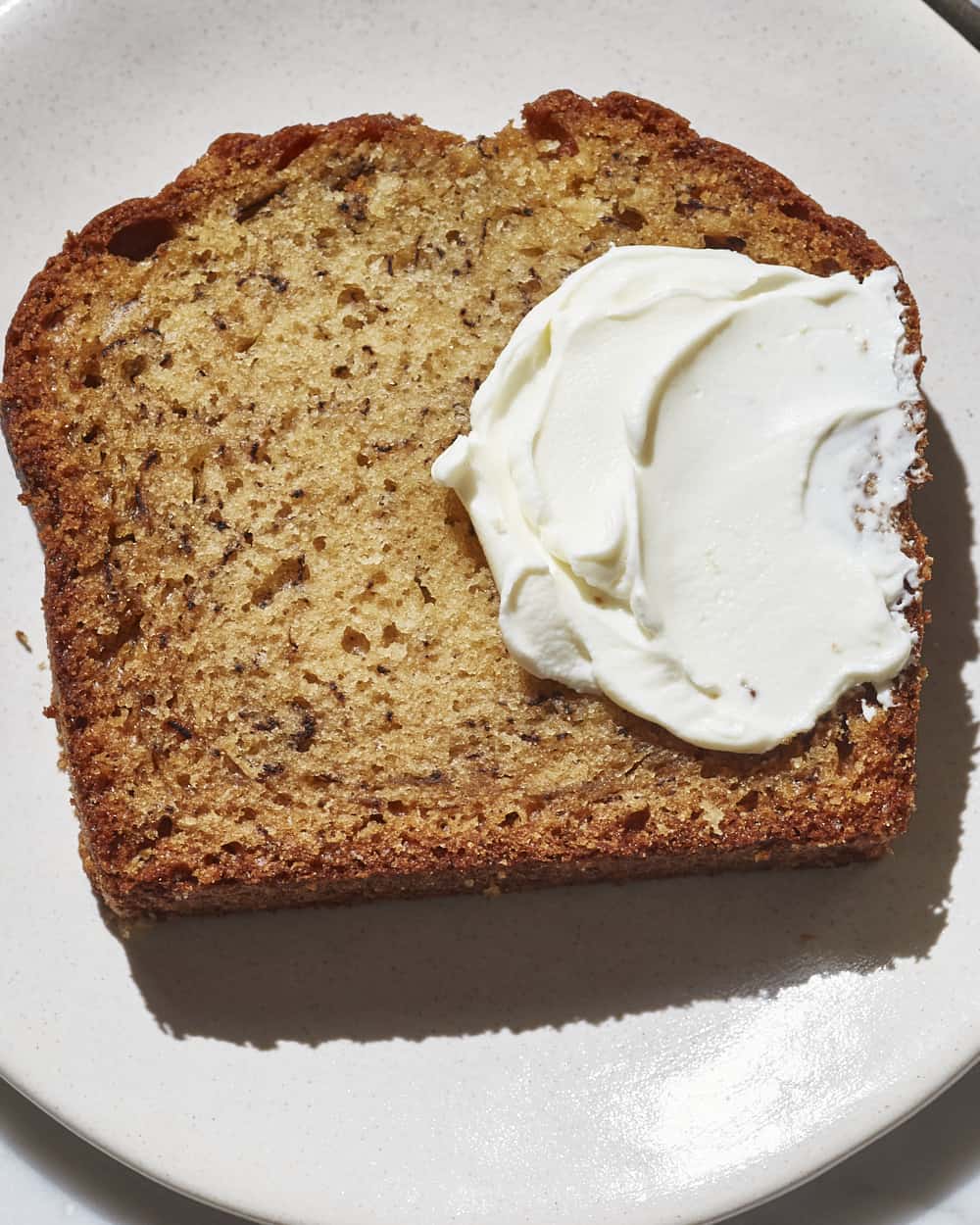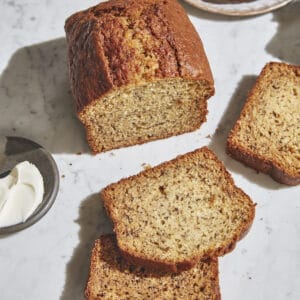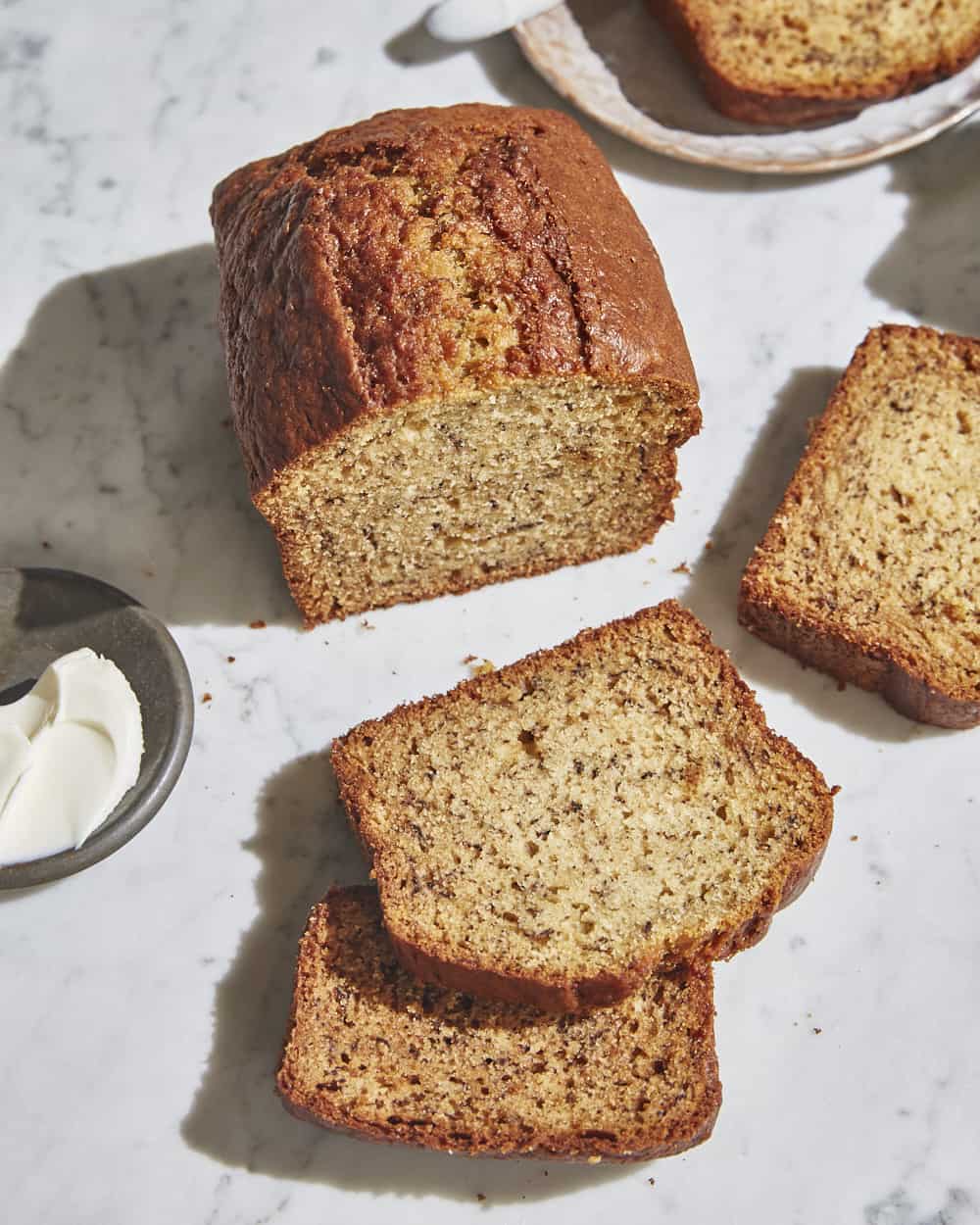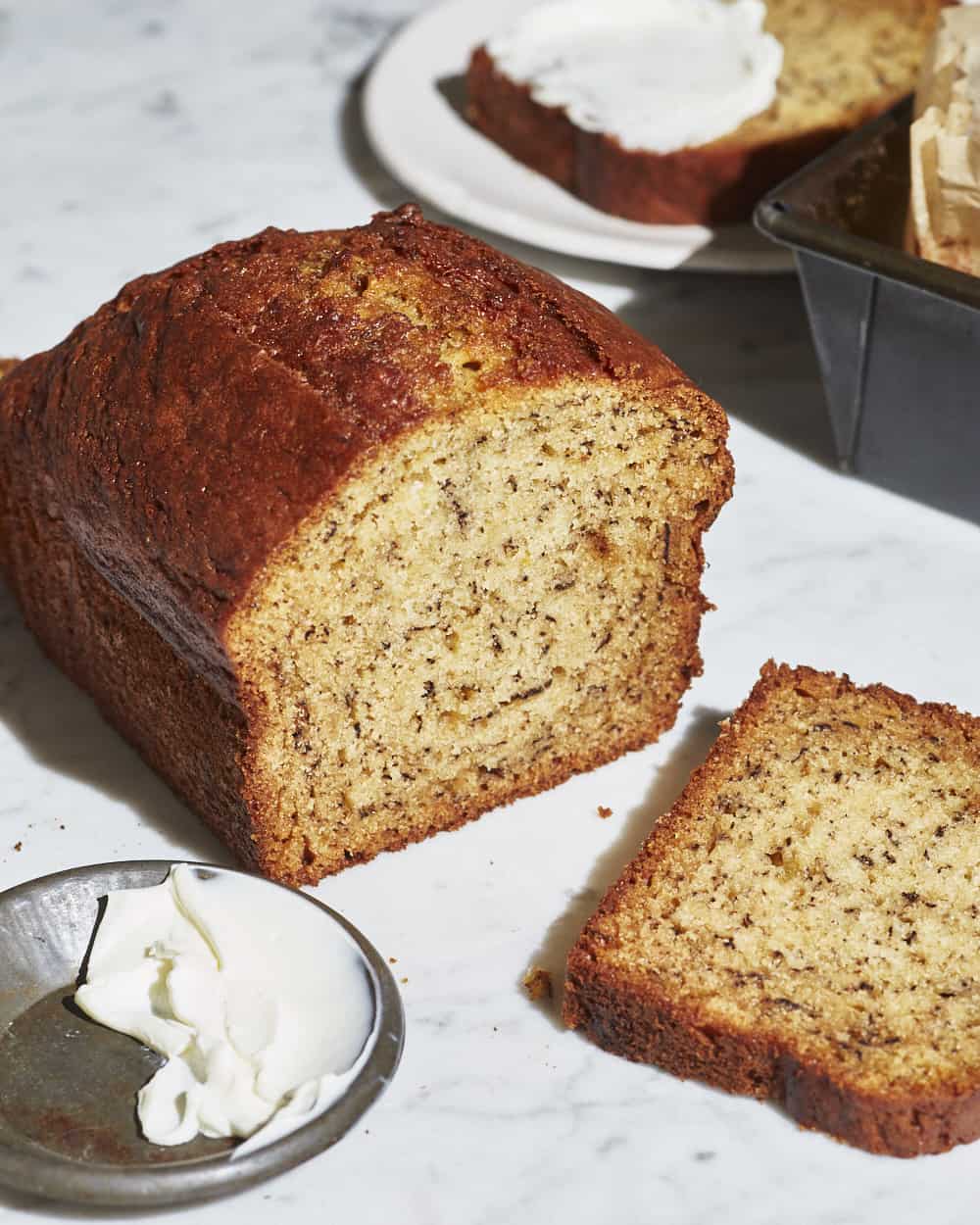
Banana bread is possibly one of the most popular things to bake! You can understand why when you see how easy it is to make – for this recipe you don’t need any fancy equipment and the batter comes together so quickly using simple ingredients. You only need one bowl to make this delicious banana loaf cake!
There’s some more in-depth info about this recipe PLUS there are some answers to FAQs about banana bread below the recipe card, so check them out for lots of info and tips.
Make banana bread with 1, 2, 3 or 4 bananas!
This recipe is super flexible and allows you to use between 1 and 4 bananas. We do this by combining whatever quantity of mashed banana with enough yogurt/milk to get a total of 250ml (or 250g).
So, if you only have 100g of mashed banana, you just add 150ml of yogurt/milk.
If you have 250g of banana, you don’t need to add any yogurt/milk.
Easy!
Other banana bread recipes:

Easy Banana Bread Recipe
Ingredients
- 1 to 4 ripe bananas
- natural yogurt or milk
- 150 g (3/4 cup) granulated, caster or light brown sugar
- 100 ml (1/3 cup + 1 tbsp) oil
- 2 eggs
- 250 g (2 cups) plain white flour (all-purpose flour)
- 1 tsp bicarbonate of soda (baking soda)
- 1/4 tsp fine table salt
Instructions
- Preheat the oven to 180°C and line a 2lb loaf tin with baking paper.
- Peel the bananas and place onto a cutting board or plate. Mash with the back of a fork until smooth. Scrape the mashed banana into a measuring jug.1 to 4 ripe bananas
- Add yogurt or milk to the jug until you reach the 250ml line (i.e. the '1-cup' line). If you only have scales, weigh how much mashed banana you have and then add yogurt until you reach 250 grams total. If you have 250ml/250g of mashed banana – you don't need to add any yogurt or milk!natural yogurt or milk
- Tip the contents of the jug into a large bowl. Add the sugar, oil and eggs then mix well until combined.150 g (3/4 cup) granulated, caster or light brown sugar, 100 ml (1/3 cup + 1 tbsp) oil, 2 eggs
- Add in the flour, bicarbonate of soda and salt. Stir together until no dry patches remain.250 g (2 cups) plain white flour (all-purpose flour), 1 tsp bicarbonate of soda (baking soda), 1/4 tsp fine table salt
- Pour the batter into the prepared loaf tin and bake for 45-60 minutes, until a toothpick (or use a piece of dry spaghetti!) inserted into the centre of the cake comes out clean. If the cake is starting to brown too much on top but is still gooey in the middle, cover it with a piece of foil to prevent the top burning.
- Tip the baked cake out onto a wire rack and leave to cool completely before slicing and serving.
- Store in an airtight container at room temp for up to 5 days.
Video

Nutrition
Variations to this recipe:
- Self raising flour instead of plain flour: use 255g self raising flour instead of the plain flour. Omit the bicarbonate of soda.
- Baking powder instead of bicarbonate of soda: use 2 1/2 tsp baking powder instead of the bicarbonate of soda.
- Butter instead of oil: use 125g melted butter instead of oil
- Make muffins instead: line a standard muffin tin with paper muffin liners and fill with the batter (should get 12 muffins). Bake for only 20-25 minutes.
- One egg: if you only have one egg, increase the amount of yogurt/banana mixture to 300ml (300g)
- Dairy-free: replace the yogurt/milk with unsweetened soy yogurt or soy milk.
- No eggs? Check out my recipe for vegan banana bread here.
- Chocolate chip banana bread: fold 100g of chocolate chips (I like dark chocolate!) into the batter just before you scrape it into the lined loaf tin.
- Walnuts: add 150g chopped walnuts or walnut pieces to the batter, just before you scrape it into the lined loaf tin
Any type of sugar for this banana bread
This recipe is quite flexible in that you can change so many parts of it and it still works e.g. you can make this recipe without brown sugar. You can use pretty much whatever sugar you want for this banana bread (except for something super coarse, like demerara sugar). The recipe works with caster sugar, golden caster sugar, coconut sugar, granulated or light brown sugar. You could use dark brown sugar but it will come out tasting noticeably more dark and caramel-y.
Plain flour or self-raising? Baking powder or bicarb?
I use plain flour for this recipe and add bicarbonate of soda to make it rise. I prefer bicarbonate of soda (baking soda) here as it introduces more toasty flavours to the loaf (it’s also useful for when you are without baking powder!).
If you need to make it without baking soda, you can replace the it with 2 1/2 tsp baking powder.
If you don’t have baking powder or baking soda: use self-raising flour instead of plain flour.
No butter? This banana bread uses oil
I like using oil in banana bread for a few reasons. It can give the bread more of a moist texture and it doesn’t have a dominant flavour so the banana aroma shines through. I also like that, unlike butter, I don’t have to soften it before using and the oil incorporates so easily into the batter.
I like to use vegetable oil (rapeseed oil) or sunflower oil. However, you could use many other oils such as: coconut oil (melted), olive oil, avocado oil, walnut oil, peanut oil.
If you want to use butter instead of oil, you can replace the oil in this recipe with 125g of melted, unsalted butter.
Make it dairy free
As the recipe uses oil, not butter, it’s already on its way to being dairy free. To replace the yogurt/milk in the recipe, simply use a plain soy yogurt or soy milk in place of the dairy versions. You could also just use a full 250ml of mashed banana meaning you’d have no need for the yogurt/milk anyway.

FAQs on banana bread
Using frozen bananas
Once bananas start to turn spotty/black, they’re super ripe and perfect for using in banana bread as they bring the most flavour and sweetness. They downside is that they start to go mouldy if left out too long so I prefer to freeze my overripe bananas, ready for use another day.
I tend to freeze bananas unpeeled. This means that in order to use them in banana bread, they need to be defrosted before I can use them. To quickly defrost frozen, whole bananas, place them into a heatproof bowl or roasting dish and cover them with freshly boiled water. Let them sit for 5-10 minutes then remove from the water. They should be soft enough to peel and squeeze out of their skins.
What makes banana bread moist?
The inclusion of mashed banana in the bread is what makes banana bread so moist. Incorporating mashed banana into batter introduces more water, making it soft and squishy. The bananas also contain different types of fibres and sugars which have water-binding abilities, helping to hold that moisture in the batter.
Which butter to use for banana bread
If you’re using butter for baking a banana bread, it’s best to use a block butter (not tub) as tub butters (i.e. spreadable) can have other ingredients in them or a lower proportion of fat, which may mess with the recipe.
When it comes to block butter, it’s best to use unsalted butter as you can control the level of salt going into your bake. However, there’s nothing wrong with using salted butter in banana bread! Just don’t add any salt to the recipe, in this case.
How much banana bread batter should be in the pan?
Usually, the batter should fill around 75 to 80% of the tin so it will be quite high up! If you’re worried that the batter is going to overflow you can either:
a) Place a baking tray under the loaf tin so that it catches any batter that overflows
b) Remove the excess batter from the loaf tin and use it to make some muffins!
How long to bake banana bread
Typically, a 2lb loaf of banana bread will take around 50-60 minutes to bake fully.
This is because the shape of a loaf tin has a low surface area to volume ratio (compared to something like a round cake tin, that is). This means that not much of the batter is in contact with the metal of the tin or the hot air of the oven, making it harder for the heat to penetrate to the centre of the loaf. This is why it takes so long to bake loaf cakes!
If you’re finding that the loaf is taking a lot longer, make sure that you’re using a metal loaf tin (ceramic or glass loaf tins will make it take longer to bake). Also ensure that your oven temperature is correct by using a cheap oven thermometer to test the calibration of your oven (many ovens run cooler/hotter than the temperature you think its at!).
Can banana bread recipe be used for muffins?
Yes, just use a standard muffin tin lined with 12 paper liners. Fill each one up and bake for 20-25 minutes, until a toothpick inserted into the centre of the muffins comes out clean.
Will banana bread stick to parchment paper?
It shouldn’t do. Parchment paper, or baking paper, are coated with a non-stick substance which is meant to prevent things from sticking to them. If you’re finding that the bread is sticking, try a different brand of parchment paper OR try greasing and flouring on top of the parchment paper, before the batter goes into the loaf tin.
How to keep banana bread from browning too much
I like to cover the top of my banana bread with foil if I feel that it’s browning too much before it’s fully baked. I do this around the 40 minute mark – the top of the loaf is set at this stage so the foil won’t stick to the cake!
Another solution (if you have heating elements at the top of your oven) is to move the loaf down a rack in your oven (it’s best to bake in the middle rack of the oven, most of the time). This is because as the loaf rises when baking, the top of it climbs closer to the heating elements at the top of the oven. If it gets too close to these heating elements, it’s more at risk of burning.
Why is my banana bread dry?
This is likely due to overbaking your banana bread. It’s best to bake it only until it is no longer wet in the middle. Baking too long will continue to remove moisture from the bread, making it dry.
Why did my banana bread collapse after baking?
- Too much raising agent: if you’ve added too much baking powder or bicarbonate of soda, the banana bread can rise excessively before having the chance to set. It can also be down to the raising agents altering the pH of the batter, which changes how and when the proteins in the batter set.
- Banana bread is underbaked: this is probably the more common issue. Banana bread typically takes a while to bake because of its loaf pan shape. If you underbake the bread, it may collapse when removed from the oven as the gas from the wet batter in the middle escapes, causing it to lose volume.
- Too much liquid: having a batter which is very wet makes it heavy and increases the water content of the batter. Both of these things make it harder for the batter to rise and set into a soft crumb when baked.
Why is my banana bread so dense?
- Incorrect amount of raising agent: if you use too much baking powder/baking soda, the cake may rise and then collapse which will cause it to be dense. If too little is used, you won’t get enough rise when it bakes so not enough air bubbles will form in the bread, making it dense.
- Raising agents are out of date: if your baking powder/bicarbonate of soda are super old (e.g. over 2 years old), they may not work any more! In this case, you need to buy new baking powder/baking soda.
- Too much liquid: when you have too much liquid for the recipe it can make the batter too heavy, preventing it from rising properly in the oven.
- Not cooked through: if the banana bread wasn’t properly set before you removed it from the oven, it may have collapsed due to still being gooey inside.
- Overmixing: if you mix your banana bread batter a lot, this starts to develop the gluten network (gluten is a protein found in flour which gives structure to bakes). This can make the texture of the bread tough and dense.
- Batter left to sit for too long before baking: when bicarbonate of soda is mixed into the batter it starts to react immediately, producing carbon dioxide gas which helps the batter rise. If the banana bread batter is left to sit for too long, the bicarbonate of soda will have all reacted before the cake is baked, meaning it won’t rise in the oven.
Can you freeze banana bread?
Yes, it’s perfect for freezing! I recommend slicing it first so that you can grab a slice straight from the freezer, without having to defrost the whole loaf. So, slice that loaf up and place into a resealable food bag (e.g. ziplock), trying to push the air out before sealing. Date & label it and then freeze for up to 3 months.
You can quickly defrost a slice by popping it into the toaster for 1-2 minutes until slightly warm.
Does banana bread need to be refrigerated?
Here in the UK, it’s generally not too hot or humid, therefore you can keep the banana bread at room temperature for up to 5 days. After this point, it may start growing mould OR may just start to dry out. It’s best to keep it in an airtight container (i.e. a tupperware box with lid) as this will stop it drying out too much.
In warmer or more humid climates, you may need to refrigerate banana bread to prevent it going mouldy. Just make sure it’s in an airtight container if you do this as this will prevent it from drying out in the fridge.


